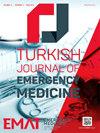印度东部三级护理创伤中心大规模伤亡事件的流行病学:一项回顾性观察研究
IF 1.1
Q3 EMERGENCY MEDICINE
引用次数: 1
摘要
目标:在世界范围内,造成大量死亡率和发病率的灾害和大规模伤亡事件(MCIs)一直在增加。急诊科(ED)服务通过优化分类和提供医疗保健所需的资源来管理mci。本研究试图描述MCI在急诊科的流行病学特征和结局。方法:本回顾性观察性研究是在一家三级医院的急诊科对2017年至2021年4年的MCI患者进行的。数据是从急诊科灾难记录和其他纸质病人记录中提取的。记录患者人口统计、到达日期和时间、交通方式、到达方式(直接或转诊)、MCI类型和机制、ED管理和结果等信息。统计分析使用R 4.1.0版本。结果:对21例MCIs进行了分析。道路交通事故(rta)是MCIs的主要原因。除爆炸伤外,MCI的大多数受害者都是男性。急诊患者年龄明显低于其他MCI组(P < 0.001)。大多数患者通过救护车(n = 120[47.1%])被送往急诊科,其次是私家车(n = 112[44.2%])。大多数MCI患者(143例[56.2%])是在晚上(下午4点至8点)被送到急诊科的。大多数受害者属于“红色”分类(n = 110[43.3%])。灾难组损伤严重程度评分显著高于其他创伤MCI组(20比17)(P = 0.014)。机动三轮车乘客是大规模伤亡rta最常见的受害者(n = 38[40%])。缝合(n = 97[50%])和包扎(n = 167[88%])是创伤性MCIs受害者最常见的ED程序。其中,167例(66%)患者从急诊科出院,47例(19%)患者入住病房,13例(5%)患者入住重症监护病房,24例(9%)患者转诊至其他中心。此外,两名患者在治疗期间在急诊科死亡,而一名患者死亡。结论:rta在MCIs中占主导地位,并影响着年轻的育龄男性人群。本研究显示了MCI病例的严重程度及其对卫生保健环境的影响,因此表明了标准化MCI管理协议的重要性。本文章由计算机程序翻译,如有差异,请以英文原文为准。
Epidemiology of mass casualty incidents in a tertiary care trauma center in eastern India: A retrospective observational study
OBJECTIVES: Disasters and mass casualty incidents (MCIs) that cause substantial mortality and morbidity have been increasing worldwide. The emergency department (ED) services manage MCIs by optimizing triage and providing health care with required resources. The present study attempted to describe the epidemiological characteristics and outcomes of MCIs presenting to the ED. METHODS: The present retrospective observational study was conducted at the ED of a tertiary care hospital on patients of MCI for 4 years from 2017 to 2021. The data were extracted from the ED disaster records and other paper-based patient records. Information on patient demography, date and time of arrival, mode of transport, method of arrival (direct or referral), type and mechanism of MCI, ED management, and outcome were recorded. Statistical analysis was performed using R, version 4.1.0. RESULTS: Analysis of 21 MCIs was conducted. Road traffic accidents (RTAs) were the predominant cause of MCIs. The majority of MCI victims, except for those of blast injuries, were men. The victims in medical emergencies were significantly younger than those in other MCI groups (P < 0.001). The majority of patients were brought to ED through ambulance services (n = 120 [47.1%]), followed by private vehicles (n = 112 [44.2%]). Most of the MCI victims (n = 143 [56.2%]) were brought to the ED during evening hours (4 pm–8 pm). The majority of victims belonged to the “Red” triage category (n = 110 [43.3%]). The injury severity score was significantly higher (P = 0.014) in the disaster group than in other trauma MCI groups (20 vs. 17). Autorickshaw occupants were the most common victims of mass casualty RTAs (n = 38 [40%]). Suturing (n = 97 [50%]) and dressing (n = 167 [88%]) were the most common ED procedures required by the victims of trauma MCIs. Of the total, 167 (66%) patients were discharged from the ED, 47 (19%) patients were admitted to wards, 13 (5%) patients were admitted to intensive care units, and 24 (9%) patients got referred to other centers. In addition, two patients died in the ED during treatment, whereas one patient was brought dead. CONCLUSIONS: RTAs dominate the MCIs and are affecting the young producative male population. The present study exhibited the severity of the cases in MCIs and their impact in the health-care setting, therefore signifying the importance of standardized MCI management protocols.
求助全文
通过发布文献求助,成功后即可免费获取论文全文。
去求助
来源期刊

Turkish Journal of Emergency Medicine
EMERGENCY MEDICINE-
CiteScore
1.70
自引率
0.00%
发文量
30
审稿时长
22 weeks
期刊介绍:
The Turkish Journal of Emergency Medicine (Turk J Emerg Med) is an International, peer-reviewed, open-access journal that publishes clinical and experimental trials, case reports, invited reviews, case images, letters to the Editor, and interesting research conducted in all fields of Emergency Medicine. The Journal is the official scientific publication of the Emergency Medicine Association of Turkey (EMAT) and is printed four times a year, in January, April, July and October. The language of the journal is English. The Journal is based on independent and unbiased double-blinded peer-reviewed principles. Only unpublished papers that are not under review for publication elsewhere can be submitted. The authors are responsible for the scientific content of the material to be published. The Turkish Journal of Emergency Medicine reserves the right to request any research materials on which the paper is based. The Editorial Board of the Turkish Journal of Emergency Medicine and the Publisher adheres to the principles of the International Council of Medical Journal Editors, the World Association of Medical Editors, the Council of Science Editors, the Committee on Publication Ethics, the US National Library of Medicine, the US Office of Research Integrity, the European Association of Science Editors, and the International Society of Managing and Technical Editors.
 求助内容:
求助内容: 应助结果提醒方式:
应助结果提醒方式:


